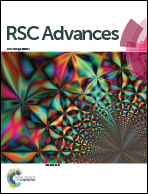Fabrication of concentric microarrays for self-assembly and manipulation of particle distribution
Abstract
We demonstrate the use of a micropatterned surface composed of a concentric circular array of SiO2 and Si layers to distribute particles from edge to centre and reduce the coffee stain effect from a colloidal or suspended solution droplet after natural evaporation by self assembly over the array. The alternating SiO2/Si layers of the concentric circular array have widths of 3 μm and depths of 400 nm, and its surface is nonhomogeneous due to the presence of the alternating hydrophilic (SiO2)–hydrophobic (Si) layers and the 400 nm variation in surface roughness. The droplet diameter, contact angle and droplet height change more rapidly from the top of such a surface compared to plain Si/SiO2 during natural evaporation. The depinning process, capillary force and Marangoni convection are the likely drying mechanisms of particle advection in the droplet. This results in even distribution on the top and side walls of the SiO2 ring and thus minimizes problems associated with the “coffee-stain” effect, providing better distribution when dispensed from a solution. The particle distribution is restricted to the top of the circular rims and the sides or the floor of the space between the rings depending on the surface energy of the ring surfaces, the structural geometry and the natural evaporation of the droplet.


 Please wait while we load your content...
Please wait while we load your content...